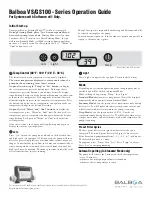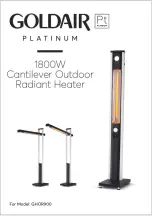
18
1.
Insert the exhaust transition into the exhaust port of the heater.
2.
Insert the flue temperature sensor into the location hole on the exhaust transition.
NOTE: IF THE FLUE TEMPERATURE SENSOR IS NOT FITTED, THE FLUE GAS MAY EXCEED THE
MAXIMUM TEMPERATURE RATING OF THE FLUE AND CAN LEAD TO SEVERE PERSONAL INJURY,
DEATH OR SUBSTANTIAL PROPERTY DAMAGE.
3.
Insert the air intake transition into the intake connection and tighten the worm drive clip.
4.
Insert the air inlet grille into the air inlet transition.
8.8.2
TYPE C
13
When the heater is installed as a Type C
13
appliance, the flue system should be installed as follows:
1.
Determine the location of the flue terminal, taking into account minimum distances as detailed in
Figure
8.1
,
Table 8.1
and the relevant British Standards.
2.
Taking care to protect the appliance from debris and dust, drill a hole in the desired location. The
diameter of the hole should be no more than 10mm greater than the diameter of the air supply pipe of
the terminal.
3.
Determine the required length of the terminal and cut as necessary.
NOTE:
When determining the required length for the flue terminal, the outer wall plate or rosette should be flush
to the wall. (See
Figure 8.6
)
NOTE:
Once cut; remove all burrs and sharp edges.
4.
Insert the terminal into the drilled hole. The terminal section should be installed level or with a fall to
outside (Max. 10mm per metre) to prevent the ingress of water.
NOTE:
When inserting the terminal, ensure the air intake section is at the bottom.
5.
Fill the void between the terminal and wall with water resistant sealant.
6.
Fit the wall plates or rosette using appropriate fixings.
7.
Install the remainder of the flue system working progressively away from the water heater supporting the
pipes as necessary.
FIGURE 8.6
HORIZONTAL TERMINAL INSTALLATION
8.8.3
TYPE C
33
When the heater is installed as a Type C
33
appliance, the flue system should be installed as follows:
1.
Confirm that the roof flashing is correct for the type of roof through which the terminal is to be installed.
(See
Figure 8.7
)
2.
Determine the desired location for the flue terminal, taking into account minimum distances as detailed
in
Figure 8.1
,
Table 8.1
and the relevant British Standards.
3.
Taking care to protect the appliance from debris and dust, drill a hole in the desired location. The
diameter of the hole should be no more than 10mm greater than the diameter of the air supply pipe of
the terminal.
NOTE:
The hole should be drilled from the outside to ensure that no damage is done to the roofing material.
Extra care should be taken to ensure that the hole is drilled vertically.
4.
Install the roof flashing and secure as appropriate.
5.
Carefully insert the roof terminal through the roof flashing and hole in the roof.
NOTE:
When inserting the roof terminal do not support or turn the terminal using the cap.
6.
Ensure the terminal is vertical using a spirit level.
Summary of Contents for EcoShield Series
Page 44: ...44 ...
















































